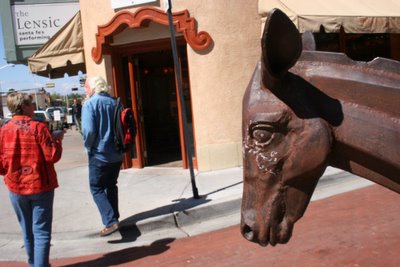
Most people, at least among the college-educated set, seemed to have rebel attitudes and social-climbing attitudes all scrambled together. Defying expectations and maybe logic, people [seem] to have combined the coutercultural sixties and the achieving
Eighties into one social ethos…The members of the new information elite are bourgeois bohemians..they are Bobos.
David Brooks, Bobos in Paradise
The house we’re staying in, an Architectural Digest-quality adobe colossus, sits at the end of a curving driveway thronged with deergrass, sagebrush and miniature sunflowers.
In a characteristic gesture, its owner has planted a cast- iron Buddha, prettily rusted, in the flowerbed below the house and has dropped a cheap floormat with the words ‘Wipe Your Paws’ near the front door, as if to show that he is simultaneously the possessor of great worldly success and too unpretentious and spiritual to care that much about it.
We’re admiring a newly acquired poolside table, a 12- foot slab of dark oak inlayed with carbon steel, when the owner, a walrus-mustache wearing consumer -rights lawyer, says those words heard so many times in this city: “We’re looking to open a gallery.”
Galleries: downtown Santa Fe has probably more of them per block than any other city in the world, from the lower- end side street tchotchke shops selling indigenous trinkets to the cool sanctora offering Ansel Adams originals for 250 grand a pop. The galleries seem the perfect institution to satisfy its clients’ need for the spiritual, the indigenous, the artistic and the material.
Even the first restaurant we visit, Café Pasqual’s, has its own gallery, displaying jewelry, traditional- type cookware, and Oaxacan Chagall pastiches.
Our first meal is breakfast at Pasqual’s, and every dish we try is a variation on the theme of earthiness: fluffy whole wheat pancakes with maple syrup ,a rib- sticking tamale with squash and peanuts, barnyard chicken breast with caramelized onions and manchego on a toasted cornmeal chile bread ,. The only disappointing plate is a Huevos Rancheros served on a mound of watery black beans with flavorless, cold tortillas.
After lunch we stroll through the mostly over- fifty crowd in the square. It’s easy to see why Santa Fe has so much appeal for prosperous aging boomers: it offers a beehive of arts and crafts production whose presiding spirit is that senescent icon Georgia O’Keefe, and a colorful and unthreatening native culture. Its high desert landscape draws so much beauty from an arid climate, a feature which must be encouraging to boomers as they confront the growing dessication of old age.
The boomer’s mythopaeia was intuited by the shrewd chef/ entrepreneur Mark Miller, whose wildly popular Coyote Café cookbook is written in a twee storybook prose:
Unlike Beaver or Squirrel, Coyote has never been known for his industriousness. Instead he revels in being clever, and you can bet that if ever there was a schemer it‘s Coyote.
At Coyote’s hangout Coyote Café, we feel you can never have too much of a good thing, which is why our motto is simply, more Chiles.”
For dinner we decide to skip Coyote Café, where, according to a friend who once worked there, crafty Coyote cuts his salsas with number ten cans of diced tomatoes, and check out Ristra.
Between the burnished plutocrats talking loudly on their cellphones and the burly servers jostling each other in this tight space, there’s a lot of testosterone in the room. We wait half an hour past the time of our reservation at the newly expanded bar and sit down to a few appetizers: a gnocchi and veal dish and a fig and arugula salad with goat cheese. The dishes arrive with disconcerting speed. The gnocchi bowl is cauterizingly hot but the stew itself is lukewarm; the veal has been chopped, Campbell’s Soup style, rather than shredded, and there are only three gnocchi in the dish. The salad, cheap broadline-distributor greens with none of the peppery bite of really fresh arugula, is overdressed in a sweet, bland fig puree dressing, which is also drizzled around the edge of the plate;the greens are mixed with fried yucca, which tastes like nothing except the oil it was cooked in.
After sending back the gnocchi and getting the same dish, slightly warmer, but still with same three gnocchi, we call for the check and head back to Pasqual’s.
The restaurant has emptied out by the time we arrive, but our laid-back server, a rumpled man in his forties wearing a pair of high top sneakers, doesn’t rush us, and recommends an excellent, jammy Zinfandel to start. We try the Caesar salad, sprinkled with spiced pecans dusted with deeply flavored chamayo chile powder, a corn pudding( similar in texture and flavor to a spoon bread) and at our server’s recommendation, the Plato Supremo., The Plato Supremo is our first encounter with the Santa Fe buffet platter aesthetic:A plate overflowing with a variety of muddy- tasting starches, including a chile relleno, a beef taco, an enchilada, rice, and a tamale, all jammed together and nearly indistinguishable in flavor. The best thing on the plate is the garnish: a fresh scallion from the local farmer’s market. The problem with New Mexican food is that it is really Mexican food, and the high starch, low protein feature of Mexican food wears easily. This type of cuisine is better suited to marathon runners than the sedentary older clientele that consumes it. We pick at a coconut flan, beautiful looking, but lacking sweetness and a little overcooked, and leave.
A little discouraged, the next day we walk across the square to The Shed, a Santa
Fe institution. There’s a half- hour wait, and by the time we’re seated, we’re starving.
A flat Coke is not a good sign and an anemic skewer of grilled shrimp with cocktail sauce doesn’t improve things. We try a combination platter which is like the Plato Supremo at Pasqual’s, only cheaper: beans, iceberg lettuce and ethylene- gassed tomatoes, red chile pork coated in stale spices, and a taco that has turned soggy from sitting in the bean liquid.
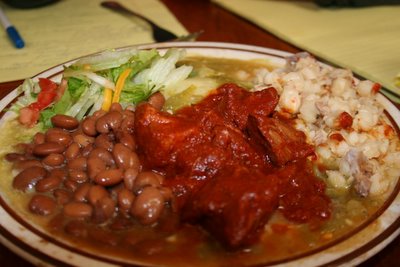
We pick at the plate, push it aside and decide to head over to the farmer’s market.
All the vitality that’s absent from the city’s restaurant scene is present at this extraordinary market , which is , on this flawless October afternoon, probably the best we’ve been to in this country.
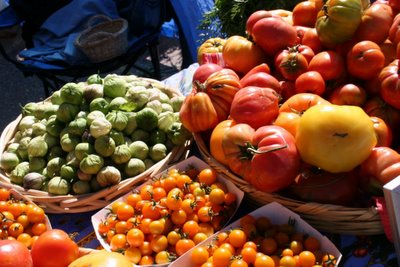
Our first stop is the Tierra Azul Farm stand. The market is winding down, but we’re so captivated by Layne Hartsell and Ann Peters, the couple who own the farm and run the stand, that we can’t tear ourselves away.
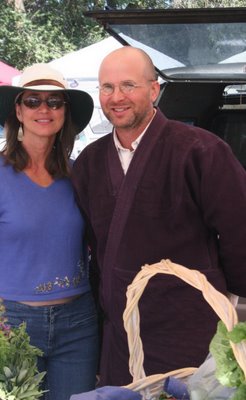
They’re so smart, funny –self-deprecating and full of radiant kindness that we spend a half an hour chatting with them. Layne is a self-styled renegade Buddhist monk and pamphleteer and Ann is a former anthropologist. This is their first year farming. They must find it hard, we inquire. No, Ann says with a smile, I’ve been growing things since I was a little girl. We buy some excellent mizuna, oyster mushrooms and squash blossoms and Layne suggests we check out Agua Santa, a small restaurant which buys their produce, for dinner.
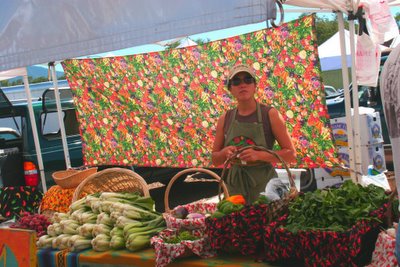
We stop by Shepherd’s Lamb, where Molly Manzanares is grilling lamb ribs on a
George Foreman grill. They are extraordinary , tender , juicy , spiked with a flavorful marinade made with garlic, sesame oil and mustard. We buy a bone-in leg of lamb and a bag of chicken wings from Pollo Real , which supplies Pasqual’s, among other places.
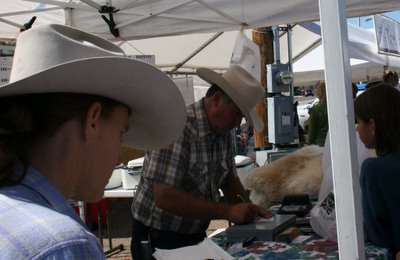
In a mood of almost frantic excitement as the market closes up,we make a few more purchases before we leave: lemon cucumbers, basil, cherry tomatoes, rosemary ,prune plums and some crisp, acidic Rome Beauty apples which we will poach the next day, roasted red and green New Mexico chiles , charred in the hand- cranked barrel chile roaster that is a feature of so many markets in the southwest.
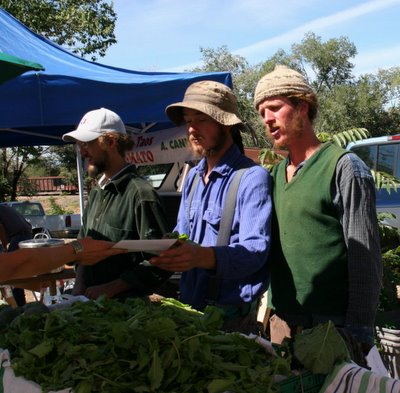
On our way back, we stop at Agua Santa, hoping to get some lunch, and find the restaurant closed and the chef-owner just back from the market.
We make reservations for that evening. It’s an elegant, quirky dining room, narrow bunker windows set in adobe walls, an open kitchen, floral china, a large country table laden with fruit and desserts, crates of vegetables lining the prep sinks that lead the way to the bathroom.
We watch the chef- owner, who is wearing a linen shirt and a dashing neckerchief, work the stoves while we scan the menu. The theme is Nouvelle Orleans, and we decide on a green salad with a sherry dressing, a sort of pizzetta with spicy rock shrimp, steamed mussels and scallops with parsley and garlic, and a duck breast with a sweet corn polenta and gypsy peppers.
The salad is impeccably fresh and perfectly dressed, the sort of thing most chefs should make well but seldom do. The pizzetta is aggressively seasoned, flavorful, but with a crust perhaps a little too thick for such an elegant restaurant.
The seafood stew is, surprisingly in this landlocked state, fresh- tasting and the best thing we try.
The polenta, with its play of corn –on corn is delicious and complex and the peppers are market fresh, but the duck is slightly overcooked and lacks the big fresh flavors of the local ingredients on the plate.
For dessert we try a Peach Melba- style Panna Cotta, served with raspberry coulis and a
peach compote. Like a surgical boob job, this Panna Cotta doesn’t wiggle when we shake it and after trampolining our spoons off the top of it we take a few unenthusiastic bites and push it aside.
We call for the check. I’ve been eavesdropping on the conversation of two older women seated next to us. They’ve been having a typical Santa Fe tête-à-tête, chatting about the opera, Zen Buddhism, menopause, and real estate values. One of the women has been telling the other about her new Black Lab.: she details the long and undoubtedly expensive process of acquiring the dog: the interviews, background checks and references for the breeders; the anti-vivisection tattoo; the GPS chip. Are you happy with the dog? the friend asks. Yeah, the other woman answers; ‘he’s an old soul and he’s great with kids. And best of all,” she smiles and leans in for emphasis,” he looks just like a mutt.”
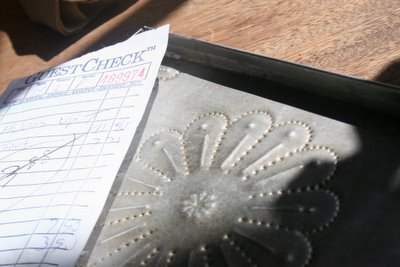
.
